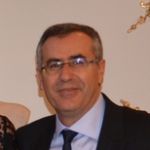Emerging/Novel concepts for high efficiency at low cost
In 1961, Shockley and Queisser (S&Q) [1] established a fundamental limit for the efficiency of single gap solar cells. Some of the premises for obtaining this limit were, for example: a) the cells operate in the radiative limit; b) one photon can create only one electron-hole pair; c) no photons could be absorbed below the bandgap. By lifting up some of these premises it is possible to device solar cells for which this limit can be exceeded. Although the phrasing “novel concepts” could be applied to almost any concept that is recent, in this section we restrict ourselves to those “novel concepts” that have been specifically proposed having in mind exceeding S&Q limit. In particular we refer to the intermediate band solar cell (IBSC), to the hot carrier solar cell (HCSC) and to the multiple exciton generation solar cell (MEGSC).
Intermediate band solar cell (IBSC). The IBSC aims to exceed S&Q by absorbing below bandgap energy photons [2]. This is achieved by engineering a semiconductor-like material that, in addition to the conventional conduction band and valence bands, exhibits an intermediate band (IB) in-between both. It is this IB the one that makes the absorption of below bandgap energy photons possible. Many approaches have been proposed for engineering this IB. We list next some of the strategies being followed to identify these materials and implement solar cells with them:
- Quantum dots [3],
- Insertion of impurities at high densities [4],
- Highly mismatched alloys [5],
- First principle calculations [6],
- Dye sensitized + TT annihilation [7]
The absorption of below bandgap energy photons in IBSC has been experimentally demonstrated [8] as well as the fact that the presence of this IB does not prevent the achievement of high output voltage in the cell [9]. A review of the experimental achievements related to IBSC research can be found in [10].
Hot carrier solar cell (HCSC). The HCSC pursues the extraction of photogenerated carriers before they thermalize [11]. The cell demands the so-called energy selective contacts in order to isoentropically cool down the carriers to room temperature [12]. It has also been postulated that electrons could be allowed to interact with optical phonons as long as a sufficiently large phononic bandgap exists between optical and acoustic phonons [13]. Resonant tunneling configurations have been suggested as the means for implementing the energy selective contacts [14]. Conibeer et al. [15] and Yao and Koning [16] have recently screened several absorber material candidates.
Multiple exciton generation solar cell (MEGSC). The MEGSC relies its potential in the possibility for a high energy photon generating more than one electron hole pair. Conceptually it has its roots in the “impact ionization solar cell”[17], a study that was motivated after observing quantum efficiencies larger than one in silicon solar cells [18]. Nozik [19] suggested the use of quantum dots (QDs) as the means to avoid some physical restrictions when implemented in bulk semiconductors, such as the conservation of the crystal momentum, leading to the MEGSC concept. External quantum efficiencies exceeding unity have been experimentally demonstrated in solar cells implemented with QDs [20].
The interested reader can find in [21] a review of the operation of the three concepts described above from the perspective of the electro-chemical potentials (quasi-Fermi levels) of electrons, photons and phonons.
[1] W. Shockley and H. J. Queisser, "Detailed Balance Limit of Efficiency of p-n Junction Solar Cells," Journal of Applied Physics, vol. 32, pp. 510-519, 1961.
[2] A. Luque and A. Martí, "Increasing the efficiency of ideal solar cells by photon induced transitions at intermediate levels," Physical Review Letters, vol. 78, pp. 5014–5017, 1997.
[3]A. Martí, L. Cuadra, and A. Luque, "Quantum dot intermediate band solar cell," Conference Record of the Twenty-Eighth IEEE Photovoltaic Specialists Conference, 2000., pp. 940-943, 2000.
[4]A. Luque, A. Martí, E. Antolín, and C.Tablero, "Intermediate bands versus levels in non-radiative recombination," Physica B, vol. 382, pp. 320-327, 2006.
[5] K. M. Yu, W. Walukiewicz, J. Wu, W. Shan, J. W. Beeman, M. A. Scarpulla, et al., "Diluted II-VI Oxide Semiconductors with Multiple Band Gaps," Physical Review Letters, vol. 91, pp. 246403-4, 2003.
[6] P. Palacios, I. Aguilera, K. Sanchez, J. C. Conesa, and P. Wahnon, "Transition-Metal-Substituted Indium Thiospinels as Novel Intermediate-Band Materials: Prediction and Understanding of Their Electronic Properties," Physical Review Letters, vol. 101, pp. 046403-4, 2008.
[7]C. Simpson, T. M. Clarke, R. W. MacQueen, Y. Y. Cheng, A. J. Trevitt, A. J. Mozer, et al., "An intermediate band dye-sensitised solar cell using triplet-triplet annihilation," Physical Chemistry Chemical Physics, vol. 17, pp. 24826-24830, 2015.
[8]A. Martí, E. Antolin, C. R. Stanley, C. D. Farmer, N. Lopez, P. Diaz, et al., "Production of Photocurrent due to Intermediate-to-Conduction-Band Transitions: A Demonstration of a Key Operating Principle of the Intermediate-Band Solar Cell," Physical Review Letters, vol. 97, pp. 247701-4, 2006.
[9]P. G. Linares, A. Martí, E. Antolín, C. D. Farmer, I. Ramiro, C. R. Stanley, et al., "Voltage recovery in intermediate band solar cells," Solar Energy Materials and Solar cells, vol. 98, pp. 240-244, 2012.
[10]Í. Ramiro, A. Martí, E. Antolín, and A. Luque, "Review of Experimental Results Related to the Operation of Intermediate Band Solar Cells," IEEE Journal of Photovoltaics, vol. 4, pp. 736-748, 2014.
[11]R. T. Ross and A. J. Nozik, "Efficiency of hot-carrier solar energy converters," Journal of Applied Physics, vol. 53, pp. 3813-3818, 1982.
[12]P. Wurfel, "Solar energy conversion with hot electrons from impact ionisation," Solar Energy Materials and Solar Cells, vol. 46, pp. 43-52, Apr 1997.
[13]G. J. Conibeer, J. F. Guillemoles, and M. A. Green, "Phononic Band Gap Engineering for Hot Carrier Solar Cell Absorbers," 20th European Photovoltaic Solar Energy Conference, pp. 35-38, 2005.
[14]J. A. R. Dimmock, S. Day, M. Kauer, K. Smith, and J. Heffernan, "Demonstration of a hot-carrier photovoltaic cell," Progress in Photovoltaics, vol. 22, pp. 151-160, Feb 2014.
[15] G. Conibeer, S. Shrestha, S. J. Huang, R. Patterson, H. Z. Xia, Y. Feng, et al., "Hot carrier solar cell absorber prerequisites and candidate material systems," Solar Energy Materials and Solar Cells, vol. 135, pp. 124-129, Apr 2015.
[16]Y. Yao and D. König, "Comparison of bulk material candidates for hot carrier absorber," Solar Energy Materials and Solar Cells, vol. 140, pp. 422-427, 9// 2015.
[17] R. Brendel, J. H. Werner, and H. J. Queisser, "Thermodynamic efficiency limits for semiconductor solar cells with carrier multiplication," Solar Energy Materials and Solar Cells, vol. 41-2, pp. 419-425, Jun 1996.
[18]S. Kolodinski, J. H. Werner, and H. J. Queisser, "Quantum efficiencies exceeding unity in silicon leading to novel selection principles for solar cell materials," Solar Energy Materials and Solar cells, vol. 33, pp. 275-285, 1994.
[19]A. J. Nozik, "Quantum dot solar cells " Physica E, vol. 14, pp. 115-120, 2002.
[20] O. E. Semonin, J. M. Luther, S. Choi, H.-Y. Chen, J. Gao, A. J. Nozik, et al., "Peak External Photocurrent Quantum Efficiency Exceeding 100% via MEG in a Quantum Dot Solar Cell," Science, vol. 334, pp. 1530-1533, Dec 16 2011.
[21] A. Marti and A. Luque, "Electrochemical Potentials (Quasi-Fermi Levels) and the Operation of Hot-Carrier, Impact-Ionization, and Intermediate-Band Solar Cells," Photovoltaics, IEEE Journal of, vol. 3, pp. 1298-1304, 2013.
Infrastructure
Expertise
 CALVET wolfram
CALVET wolfram
 SCHMID Martina
SCHMID Martina
 ROCA Francesco
ROCA Francesco
 CASTRO Fernando Araujo de
CASTRO Fernando Araujo de
 BRITES Maria João
BRITES Maria João
 CORREIA José Brito
CORREIA José Brito
 BINETTI Simona
BINETTI Simona
 VEENSTRA Sjoerd
VEENSTRA Sjoerd
 AHLSWEDE Erik
AHLSWEDE Erik
 BROWN Thomas M
BROWN Thomas M
 REALE Andrea
REALE Andrea
 DI CARLO Aldo
DI CARLO Aldo
 SÁNCHEZ Guillermo
SÁNCHEZ Guillermo
 PONCE-ALCÁNTARA Salvador
PONCE-ALCÁNTARA Salvador
 MARTÍ Antonio
MARTÍ Antonio
 ACCIARRI Maurizio
ACCIARRI Maurizio
 MELLIKOV Enn
MELLIKOV Enn
 KAUK-KUUSIK Marit
KAUK-KUUSIK Marit
 BUECHELER Stephan
BUECHELER Stephan
 TIWARI Ayodhya Nath
TIWARI Ayodhya Nath
 LUX-STEINER Martha
LUX-STEINER Martha
 ENNAOUI Ahmed
ENNAOUI Ahmed
 BECKER Christiane
BECKER Christiane
 NORDSETH Ørnulf
NORDSETH Ørnulf
 DURRANT James
DURRANT James
 NELSON Jenny
NELSON Jenny
 EMMOTT Christopher
EMMOTT Christopher
 BRUNETTI Francesca
BRUNETTI Francesca
 CLAUDIO Gianfranco
CLAUDIO Gianfranco
 CONNOLLY James
CONNOLLY James
 VISOLY-FISHER Iris
VISOLY-FISHER Iris
 KREBS Frederik C
KREBS Frederik C
 MANLEY Phillip
MANLEY Phillip
 LUQUE Antonio
LUQUE Antonio
 BELIATIS Michail
BELIATIS Michail
 NEVES Filipe
NEVES Filipe
 BARREIROS M. Alexandra
BARREIROS M. Alexandra
 TUCCI Mario
TUCCI Mario
 LANCELLOTTI Laura
LANCELLOTTI Laura
 NENNA Giuseppe
NENNA Giuseppe
 MITTIGA Alberto
MITTIGA Alberto
 SLAOUI Abdelilah
SLAOUI Abdelilah
 GARCÍA-LINARES Pablo
GARCÍA-LINARES Pablo
 DILETTO Claudia
DILETTO Claudia
 GRILLI Maria Luisa
GRILLI Maria Luisa
 REY-STOLLE Ignacio
REY-STOLLE Ignacio
 TRIFILETTI Vanira
TRIFILETTI Vanira
 RAMIRO GONZÁLEZ Iñigo
RAMIRO GONZÁLEZ Iñigo
 ROMANYUK Yaroslav
ROMANYUK Yaroslav
 HAUG Halvard
HAUG Halvard
 EZQUER Mikel
EZQUER Mikel
 ZUGASTI Eugenia
ZUGASTI Eugenia
 RODRÍGUEZ María Jesús
RODRÍGUEZ María Jesús
 LANG Felix
LANG Felix


